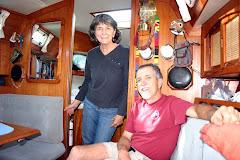After a week in the bay, we've already anchored in all 3 spots, and are currently in Las Hadas for the 2nd time. Our bud Kris on s/v Rocket Science is here, and as at Chamela, we've enjoyed sharing a few dives with him. Our underwater camera doesn't seem to be very waterproof, so we are not taking it underwater any more. The pictures below were all taken by Kris with his Sony camera in an Ikelite housing.
Here's me at a dive site on the Julupan Peninsula, just outside of Santiago.

Although you can easily snorkel it, we enjoyed a dive on the wreck of the 300' San Luciano, at the SW end of Santiago Bay.

We found this odd couple, a balloonfish and a green moray, hanging out together near the stern of the wreck.

A reef stingray prowls the sand around the wreck.

This colorful nudibranch, about 2" long, is tentatively identified as Hypselodoris agassizii, one of about 100 species of nudibranchs found in Mexico. Between us, Chris and I have seen 5 different species so far.

The rest of these photos were taken either at the Julupan Peninsula site, or at Los Frailes, a set of rock pinnacles about a mile out in the center of the bay.
Another dorid nudibranch, tentatively identified as Glossodoris sedna.

This is a well-camouflaged scorpionfish.

A juvenile Cortez angelfish.

Some soft corals (or possibly anemones).

Finally, although we usually have to look hard to spot eels, this Jewel Moray was right out in the open next to our anchor at the end of one dive.


No comments:
Post a Comment